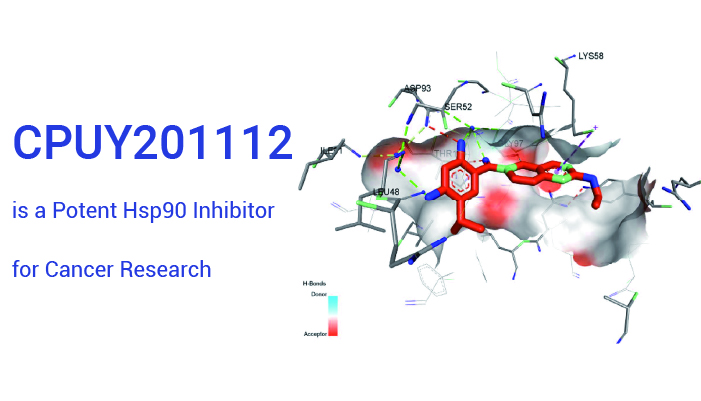Hsp90 (heat shock protein 90) is a chaperone protein that helps other proteins fold correctly, stabilizes proteins against heat stress, and aids in protein degradation. Besides, it stabilizes many proteins needed for tumor growth, which is why Hsp90 inhibitors severe as anticancer drugs. Importantly, it exists in a variety of different organisms from bacteria to mammals, including the prokaryotic analog HtpG (high-temperature protein G). That shares 40% sequence identity and 55% similarity with the human protein. In addition, the normal function of Hsp90 is essential to maintain the health of cells. So its dysregulation may lead to cancer. Next, the chaperone’s ability to stabilize the 26S proteasome and to stabilize kinases targeting the same proteasome demonstrates its functional versatility. So, the use of Hsp90 inhibitors in cancer therapy highlights the importance of Hsp90 as a therapeutic target.

CPUY201112 is a potent Hsp90 inhibitor for cancer research.
CPUY201112 is a potent heat shock protein Hsp90 inhibitor with Kd of 27 nM. Firstly, it induces p53-mediated apoptosis in MCF-7 cells, resulting in cell cycle arrest, which can be used in cancer research. Secondly, it (0-9 μM, 7 days) reduces the viability of multiple cancer cell lines such as HCT116 colon cells, HepG2 hepatocellular carcinoma and other cancer cells in a dose-dependent manner. Also, it inhibits MCF-7, A549, HCT116, and HepG2 cells with IC50 values of 0.624, 0.543, 0.763 and 0.342 μM, respectively. Besides, CPUY201112 (0-2 μM, 24 h) can induce apoptosis in a dose-dependent manner.
CPUY201112 (5-40 mg/kg, i.p., daily, 3 weeks) inhibits tumor growth in the MCF-7 tumor xenograft model. It reduces tumor volume by 11.92%, 26.58% and 39.63%, respectively, when using 5 mg/kg, 20 mg/kg and 40 mg/kg. Moreover, it significantly induces the expression of Hsp70 and reduced the expression of Akt at 40 mg/kg.
In conclusion, CPUY201112 is a potent heat shock protein Hsp90 inhibitor that induces p53-mediated apoptosis and cell cycle arrest in MCF-7 cells, which can be used for cancer research.
References:
[1] Xiao-Li Xu, et al. Sci Rep. 2016 Jan 8;6:19004.
[2] Abdullah Hoter, et al. Int J Mol Sci. 2018 Aug 29;19(9):2560.